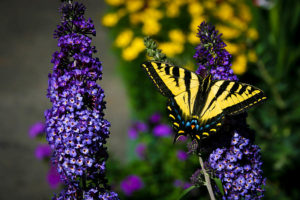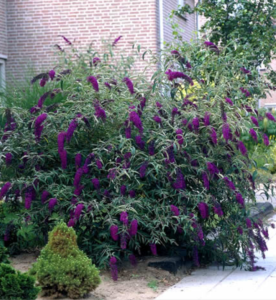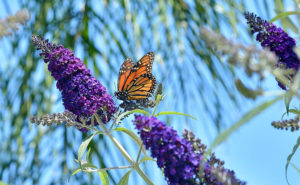All About Butterfly Bush
A Pollinators Dream Plant
If you’re looking to attract beautiful butterflies and hummingbirds to your garden with a consistent blooming plant then look no further than the butterfly bush! The lovely butterfly bush is a genus of woody flowering perennial that grow appealing fragrant flower spikes that are known to attract pollinators from late spring to fall. The blooms come in a wide variety of colors such as white, pink, red or shades of purple, while the foliage color may be chartreuse or grayish blue. These low maintenance plants require little work beyond well-drained soil and good sunlight. The butterfly bush has a fibrous root system, instead of a taproot, which means the roots get their nutrients from the upper layers of soil.
General Overview
- Sun (grows well in part sun but blooming may be reduced)
- Attracts birds, bees and hummingbirds
- Drought tolerant once established
- Great cut flowers
- Low maintenance
- Deer and rabbit resistant
- Plant size and bloom color is variety specific
Where and When to Plant
Butterfly bushes can do well in any garden or landscape that receives adequate amounts of sun (6 hours or more) and has well draining soil. Their graceful arching habit is appealing as a background in informal gardens, and smaller varieties may be grown closer to the front border as accents or in groupings. The best time to plant this variety is spring or fall, right before frost.
Care Requirements
Watering
During the first growing season, keep the soil around the roots thoroughly moist, but not waterlogged. Water when the soil seems dry. To help maintain healthy roots, use a moisture meter to gauge how wet or dry your plant really is! An established butterfly bush is fairly drought resistant, and only needs watering during long dry spells. Wilted leaves will likely indicate your plant is dry but always check the soil, as wilted leaves can also be a sign of roots staying too wet.
Fertilizing
This variety of perennial does not require constant fertilization. With good, pH balanced soil annual fertilizing will be more than adequate. It is best to fertilize butterfly bushes once every spring. We suggest using Jump Start or Espoma Flower Tone.
Pruning and Deadheading
While butterfly bushes are quite low maintenance overall, annual pruning and regular deadheading is recommended to maintain your plant’s best health. Deadheading your plants means snipping off any browning flower clusters to encourage more flowering though the bloom season. Butterfly bushes bloom best on younger, vigorous growth and later in the season. Pruning back annually early in spring before the plant leafs out will help remove any broken or winter-damaged branches from your plant and encourage new shoots. Check out our other posts on pruning to read more about specific techniques and the right way to take care of your garden.
Size Options: Large verses Dwarf
Butterfly bushes come in 2 general categories- a “larger” size that grows between 3 to 5 feet in width and 5 to 10 feet in height and the “dwarf” size that grows between 2 to 4 feet in width and 2 to 4 feet in height. There are various colors and bloom shapes that come in both categories. A couple of our favorites at the nursery are Dark Knight, and both the Pugster and new Tower series. To see what we have in stock, please visit our Butterfly Bush inventory page.
Large Variety: Dark Knight
The Dark Knight Butterfly Bush, also known as the Black Knight, produces rich purple flower spikes that can grow up to 10 inches long! The deep purple blooms are complemented by dark green leaves with whitish undersides. The spikes have an upward growth pattern and the bush can quickly reach 6 to 8 feet tall and 4 to 6 feet wide. A fast growing variety that requires little maintenance, the Dark Knight is a gorgeous plant to consider for your borders and landscapes and can even provide additional privacy when in maturity.
Dwarf Variety: Pugster series
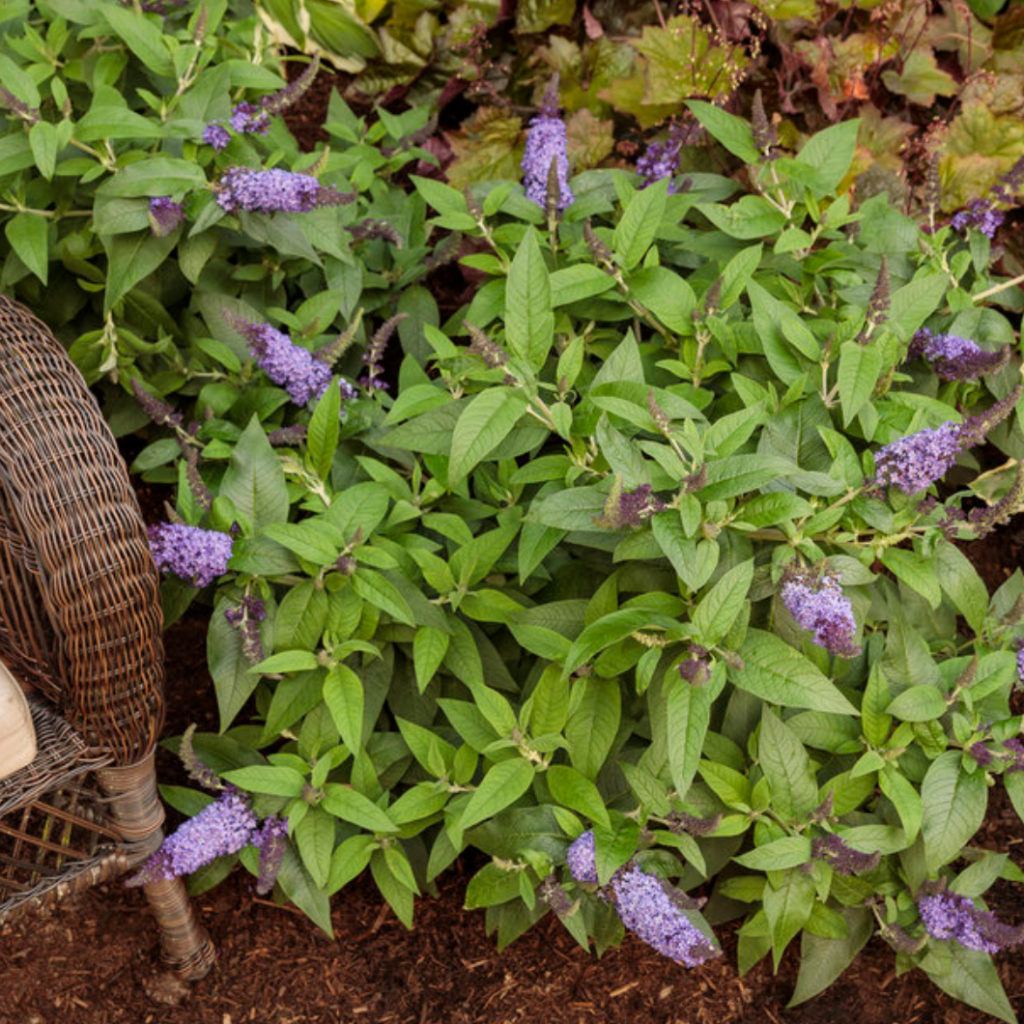
This dwarf butterfly bush series blooms in a variety of colors and features larger blooms than most dwarf varieties. Pugsters have a wider spread than height, with a height averaging 2 feet and a width between 2 and 3 feet. You should expect a continuous bloom on Pugsters from summer to fall; and while deadheading doesn’t hurt, it isn’t requires with this series. It grows quickly in hot heat and sunny spots. The Pugster series is known for its’ sturdy stems and better winter hardiness than other dwarf butterfly bushes.
Narrow Variety: Tower series
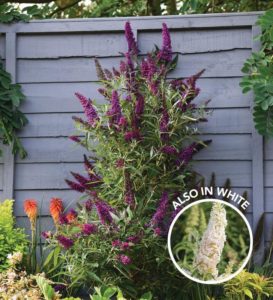
We are very excited about the landscape opportunities that the Tower series offers! For small gardens (or large gardens that don’t have much room left for addtions), this butterfly bush is a great option. Mature size is 4-5 feet tall and only 2-3 feet wide! It’s available in both the white and magenta color options. This is a Southern Living plant selection, so you know it’s a good one, providing a tower of blooms all summer!
Butterfly Bush Verses Butterfly Weed
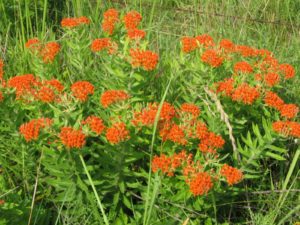 We often have customers come in looking for Butterfly Bushes and end up asking for the Butterfly Weed, specifically Asclepias tuberosa! While both plants can be great growers in Arkansas and both attract pollinators, the overall look of the plants is quite different. Butterfly Weed grows flat-topped flower clusters in orange to orange reds and yellow colors. Butterfly Weed typically grow between 1 to 3 feet in height and 1 to 2 feet wide. They are also slower to mature and produce abundant blooms, unlike the Butterfly Bush’s quick growth pattern. For more information on the Butterfly Weed and other pollinator plants, check out some previous blogs dedicated to this topic in the following links:
We often have customers come in looking for Butterfly Bushes and end up asking for the Butterfly Weed, specifically Asclepias tuberosa! While both plants can be great growers in Arkansas and both attract pollinators, the overall look of the plants is quite different. Butterfly Weed grows flat-topped flower clusters in orange to orange reds and yellow colors. Butterfly Weed typically grow between 1 to 3 feet in height and 1 to 2 feet wide. They are also slower to mature and produce abundant blooms, unlike the Butterfly Bush’s quick growth pattern. For more information on the Butterfly Weed and other pollinator plants, check out some previous blogs dedicated to this topic in the following links:
https://thegoodearthgarden.com/grow-butterfly-weed/
https://thegoodearthgarden.com/4118-2/
Overall, the Butterfly Bush is an excellent perennial choice for gardens with sun to part sun, well drained soil, and a gardener that loves hummingbirds, butterflies, and other wildlife! With its beautiful bloom shape, rich colors, and variety of sizes to choose from, the Butterfly Bush could be a great addition to your home!
